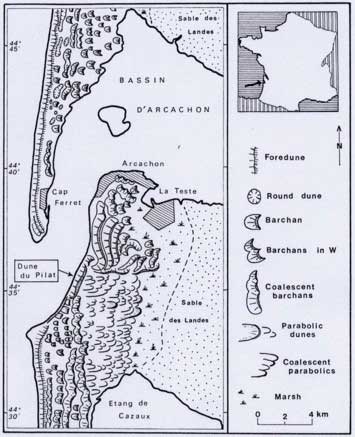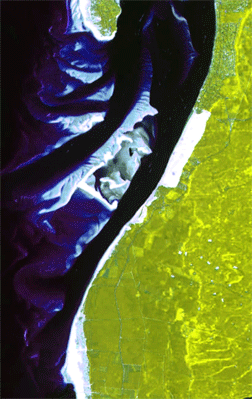Geography of the Great Dune of Pyla
The two main areas of the western part of Aquitaine.
 The western part of the Aquitaine region is covered by sands in continental and coastal dunes. This region is planted by pines (the largest pine forest in Europe) during the XIX century, may be subdivided into two areas, as follows:
The western part of the Aquitaine region is covered by sands in continental and coastal dunes. This region is planted by pines (the largest pine forest in Europe) during the XIX century, may be subdivided into two areas, as follows:
1 – A great plain called “Les Landes de Gascogne” (the sandy moor of Gascony) contains numerous continental dunes, generally parabolic dunes and sand ridges (Enjalbert, 1960; Legigan, 1979).
2 – The area of coastal dunes, which is 8km wide and 230km long from the Gironde (Pointe de Grave) to Biarritz in the South. Since the end of the XIXth century, these coastal dunes have been covered by a pine forest.
The “Landes de Gascogne” forms a green triangle (Pine forest) with the Gironde estuary to the North and the Atlantic Ocean to the West. The coastal dunes are located between lakes and the shoreline.
The coastal dunes.
These dunes can be classified into four categories in terms of morphology, from East to West : 1- parabolic dunes, 2- crescentic or barchan dunes, 3- round dunes (caoudeyre), 4-foredune or Aeolian sand barrier along the shore. All these dunes show asymmetrical morphology, with abrupt slopes leeward to the East and gentle slopes windward to the West. Clearly they have been shaped by westerly winds.
These coastal dunes cover the soil of the sandy moor of Gascony. The parabolic dunes correspond to the first coastal individualised dunes. They were covered by pine forest before the XVIIth century.
They were called “Primitive dunes” by Durègne. These dunes are located between the lakes. Toward the South, they form the great majority of coastal dunes. The barchans cover an area continuous from the Gironde estuary to Moliets, in the South. Sometimes they coalesce to form great ranges of dunes.
The round dunes, also called chaotic dunes, are smaller than the barchans and the parabolic dunes, usually less than 20m in height. They are located between barchan and foredune areas. The foredune, an Aeolian sand barrier behind the sandy beach, has been greatly promoted since 1890 by works made to stop sand drift (i.e. palisades and planting of grass Ammophila arenaria). Unlike the barchan and parabolic dunes, which are fixed by forest, the foredune has a character which changes in terms of wind velocities and grass cover.
This foredune is actively managed by the “Office National des Forêts” (National Forest Agency) by means of permanent workers who replant grasses to reduce the Aeolian drift and to protect the pine forest.
The coastal dunes close to the Arcachon Bay and the location of the Great Dune of Pyla.
In terms of amplitude, the whole areas of coastal dunes includes:
1 dune above 100m height, the Great Dune of Pyla (or Pilat),
47 dunes between 70 and 100m in height,
350 dunes between 50 and 70m in height,
710 dunes between 30 and 50m in height,
410 dunes between 10 and 30 in height.
So in this area, there are over 1500 dunes with amplitudes of more than 10m. The total volume of these coastal dunes may be estimated at between 10 and 20x109m3 (Legigan, 1979; Froidefond, 1985). Observation of the orientation of dune axes may give information on the direction of the wind shaping the dunes. Results of about 600 observations reveal that coastal dunes have been shaped by westerly winds without appreciable changes between barchans and parabolic dunes.
Sedimentology of the dune sands
The coastal dunes consist predominantly of siliceous grains with 1 to 2% of heavy mineral grains. That are Aeolian sands, very well sorted, with a mean grain size of about 0.35mm. The mean grain size of the foredune changes from North to South. The mean size decreases from 0.35mm near Soulac to reach a minimum of O.25mm near Arcachon. Farther South, the mean grain increases progressively and reaches 0.40mm near Bayonne. The beach sands are generally coarser than the dune sands with a mean grain size of between 0.35 and 0.5mm. The submarine shore and the inner continental shelf, between 0 and 50m depth, are generally covered by sands and coarse sands (Allen et Castaing, 1977).
Located on the edge of the bay inlet, at 5km from Arcachon, this great transverse dune is 2500m long and 500m wide and reaches a height of 107m. Its volume is approximately 60x106m3.
The slope of the East side is between 30 and 40°, and the slope of the West side between 5° and 20°.
The crest has an altitude fluctuating between 70m and 107m, and small barchans alternate with wind corridors. This dune progressively moves inland, the East side invading the Pine Forest. View from space (Spot satellite image), this dune appears as a white rectangle along the Pyla shoreline.
Inlet of the Arcachon Bay with the Great Dune of Pyla.
Ce message est également disponible en : French



